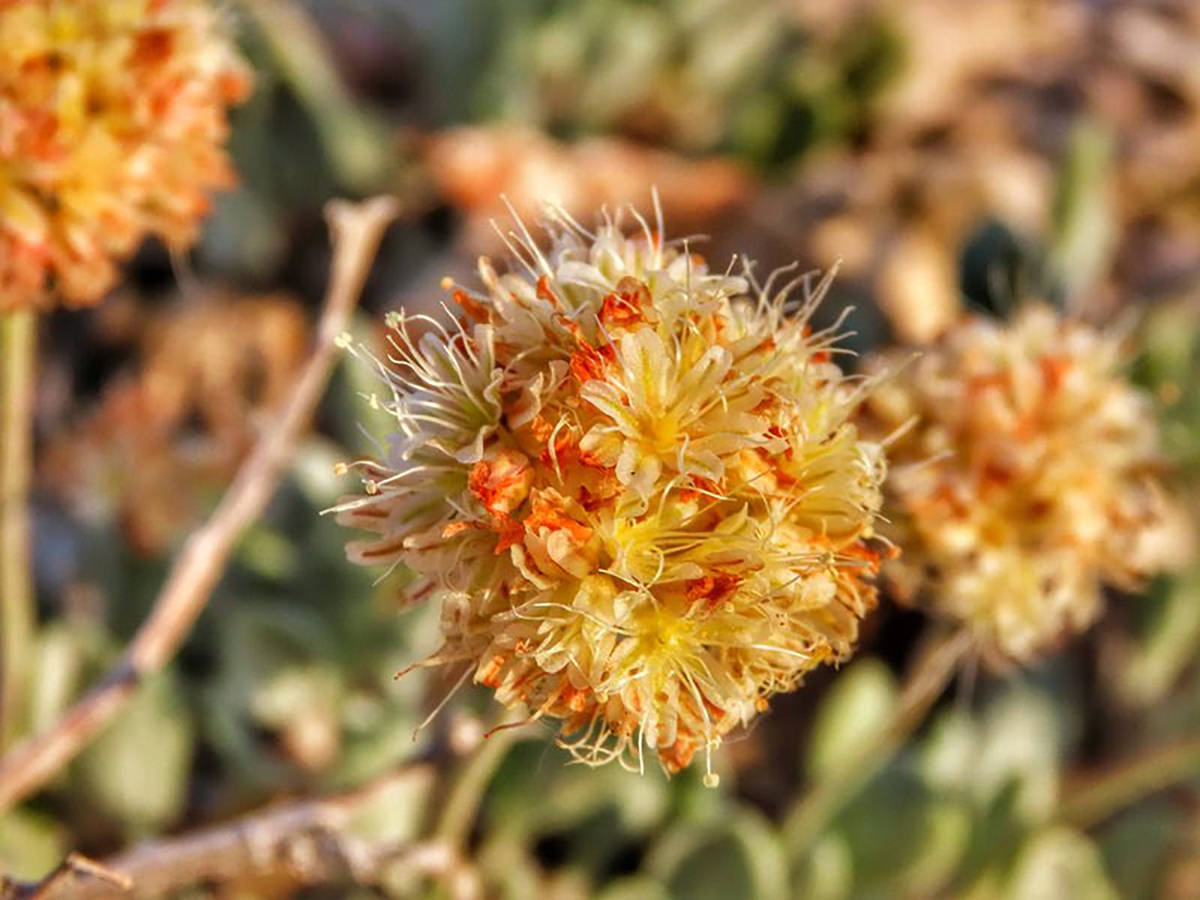Conservationists say thousands of rare wildflowers ‘dug up and destroyed’
Conservationists discovered over Labor Day weekend that someone had dug up and destroyed more than 17,000 Tiehm’s buckwheat plants, a rare Nevada wildflower the U.S. Fish and Wildlife Service said this summer might warrant protection under the Endangered Species Act.
As much as 40% of the flower’s global population, which exists on just 21 acres in western Nevada, might have been destroyed.
“This is an absolute tragedy,” said Patrick Donnelly, Nevada state director at the Center for Biological Diversity. “Tiehm’s buckwheat is one of the beautiful gems of Nevada’s biodiversity, and some monster destroyed thousands of these irreplaceable flowering plants.”
A routine visit to the site by CBD staff revealed substantial impacts to all six subpopulations of the flower, with some subpopulations nearly wiped out. Plants were dug up or mangled with shovels, with taproots cut and most of the dead buckwheats hauled off-site.
Tiehm’s buckwheat has been the subject of recent controversy. An Australian mining company, Ioneer Corp., has proposed an open-pit lithium mine.
After a whistleblower revealed mismanagement of the species by the Bureau of Land Management, the CBD submitted an emergency petition to protect the plant under the Endangered Species Act in 2019. In response, the Fish and Wildlife Service said in July the plant’s protection “may be warranted” and initiated a year-long review.
After the initial discovery of the incident, a field survey conducted by Donnelly and Dr. Naomi Fraga, director of conservation at the California Botanic Garden, revealed approximately 40% mortality to the species across all subpopulations, due to removal or destruction.
“This appears to have been a premeditated, somewhat organized, large-scale operation aimed at wiping out one of the rarest plants on Earth, one that was already in the pipeline for protection,” said Donnelly. “It’s despicable and heartless.”
Ioneer on Wednesday issued a statement suggesting that the cause of the destruction was natural.
“While an investigation by various government offices, and by Ioneer’s botanist team is ongoing, initial reports show that the cause of this unfortunate situation is a rodent attack,” the statement read. “There is no suggestion nor indication that this attack was perpetrated by humans as falsely stated by Center for Biological diversity. This is a baseless accusation and strikes at the heart of CBD’s credibility.
“While CBD is making these outlandish claims, our company is working hand in hand with state and federal authorities to get to the bottom of this situation. If CBD was serious about actually protecting the species, they would commit to joining the effort to address the problem, rather than spreading false information that only impedes our efforts.”
Donnelly was quick to reject the premise that animals were responsible for the damage.
“We think it’s patently false that small animals or herbivory could have done this,” Donnelly said. “The idea that an army of small mammals descended on the area that this mine is located, selectively chose to eat only the rare wildflower that has caused a controversy with said mine, left perfectly shovel-sized holes through the ground like it was Swiss cheese, left no sign of themselves such as droppings or footprints and vacated the site such that there was no trace of them when we were there is ludicrous.”
In a letter sent Tuesday to the Bureau, U.S. Fish and Wildlife Service, Nevada Division of Forestry and Ioneer Corp., Fraga and Donnelly made a series of recommendations to the agencies, including fencing the site, 24-hour security and immediate stabilization and rehabilitation of affected plants.
Plants can recover from extreme trauma such as that inflicted upon Tiehm’s buckwheat if given protection and potential assistance through plant care, propagation and transplanting. The letter urges the agencies to immediately commence a protection and restoration program.
“I have never seen small mammal damage of that scale ever in my life, especially to a buckwheat,” Fraga said. “We saw whole plants decapitated with their woody roots exposed, thousands of them, and perfect circular holes throughout the habitat. It was a systematic removal of plants in all subpopulations.
“Also buckwheats have many adaptations to deter herbivory including having compounds in their leaves that make them unpalatable, so it seems highly unlikely that herbivory would ever be a problem at this scale.”
Samantha Thompson of the state Department of Conservation and Natural Resources, said that while the investigation is continuing and the cause has yet to be determined, the evidence reported is consistent with herbivore activity. That evidence includes variations in the degrees of damage, from plants completely uprooted and intact, plants uprooted and further shredded and scattered, plants partially excavated from above with roots in place but partially gnawed, plants apparently uprooted from beneath, plants shredded but not excavated and intact plants where adjacent digging had begun but stopped before reaching roots.
Where roots had been severed, the breaks were ragged, not straight and “clean,” and the bark was missing near the ends, Thompson said. There were no reports of tool marks. Human and other large footprints were not in the immediate vicinity of most of the disturbed plants, and any footprints observed were consistent with recent past survey visits to the sites.
Small rodent burrows were visible in some photographs, Thompson added, and a field report noted small unidentified mammals scattering ahead of a vehicle on an access road between populations. Identification and assessment of other evidence, such as possible droppings, is currently underway as part of the current site investigation.
Thompson said the Nevada Division of Forestry is in the final stages of determining whether a listing is warranted for the Tiehm buckwheat and anticipates announcing its decision within 30 days.
A Leger Lab technician dispatched to investigate the site rported that quite a few of the mature plants in the area around the first subpopulation had holes dug around their bases. Many plants were completely excavated and were lying beside the holes with their taproots severed. The cuts on the taproots were not straight and clean as if they had been mechanically clipped, but were uneven, with ragged edges and bark missing near the ends, suggesting that they had been gnawed off.
In addition, no human or large animal tracks were seen surrounding the holes, and the disturbance looked similar to what had been observed at transplant sites earlier in the summer, which had primarily been caused by “a couple of species of small rodents.”
At the second planned survey site, lab techs saw “a lot of footprints at this site, both human and something with hooves, maybe deer, sheep, or pronghorn, and some evidence of an erosion channel forming in one part of the hillside.” But right around the plants, there no big footprints, and there was extensive digging that affected roughly half of the plants. Again, there was no evidence that the holes were caused by large mammals.
As the team was driving toward the third site, several small furry animals were seen racing off of the road ahead of the truck, but they were too small and the crew was moving too fast to identify them. Rabbit droppings were observed as were occasional holes that looked like burros and minor depressions dug closer to the shrubs.
The same pattern as seen at the other subpopulations was observed, with many plants having big holes dug at the base, many severed and lying whole or shredded by the holes. Some plants that weren’t totally severed had evidence of chewing on the main taproot. There were also some plants where it looked like digging had begun, then been abandoned before the roots were reached.
Regardless of cause, more than 40% of the population of a very rare species has been destroyed, and stakeholders are upset.
“I was absolutely devastated when I discovered this annihilation of these beautiful little wildflowers,” Donnelly said. “But we’re not going to let this stop our fight against extinction. We’ll fight for every single buckwheat.”
This is a developing story. Check back for updates.

















